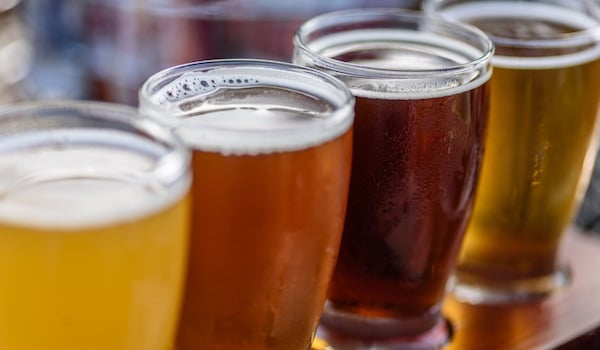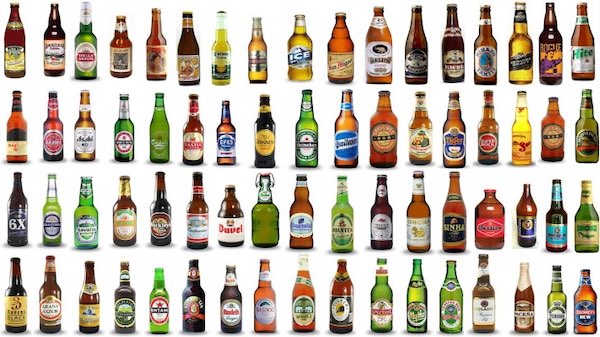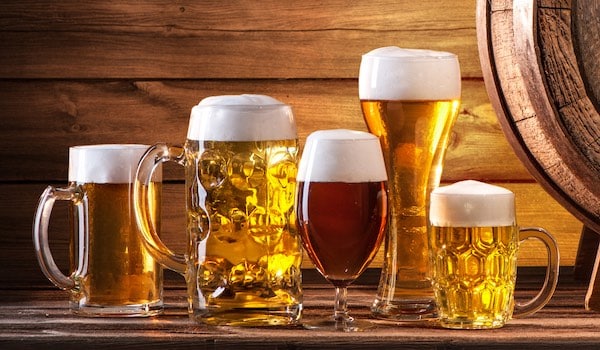
In This Article
- Introduction
- Shared Characteristics of Lagers & Ales
- What is an Ale Beer?
- Flavor Profile Ales
- Popular Types of Ales
- What is Lager Beer?
- Flavor Profile of Lagers
- Popular Lager Styles
- What is Malt Beer?
- Flavor Profile of Malt Beers
- Popular Types of Malt Beers
- Key Differences: Ale vs Lager vs Malt Beer
- Which One Should You Choose?
- Conclusion
- Sign Up for Our Newsletter Here
Introduction
In today’s craft beer world of seemingly infinite variety, it might seem crazy that the beverage can be boiled down to a few categories. Lagers, ales, and malt beers are distinct types of beer; every style you’re familiar with falls under one of these. Each is defined by its fermentation process. As a drinker, this can also help you know what to expect when deciding on one of the 40 taps at your local bar or taproom.
RELATED ARTICLES:
What Is Ale Beer and How is Ale Made? Expert Guide
Different Types of Beer: A Breakdown of Every Style
Shared Characteristics of Lagers & Ales
Common Brewing Process
Despite their differences, the brewing process for both lagers and ales employs the following steps: malting, mashing, boiling, and fermenting. Even the baseline ingredients of water, barley, hops, and yeast are used in brewing ales, lagers, and malt beer.
Mashing and Boiling
In both beer styles, malted barley is mashed with hot water to convert starches into fermentable sugars. After mashing the barley into wort, it’s boiled while hops and other ingredients are added for bitterness, aroma, and flavor. Hopping happens regardless, but this is also where much of the experimentation happens. Lagers and ales can have similar hop varieties, but ales tend to use more aromatic hops due to higher fermentation temperatures.
Fermentation Differences
Now the fermentation happens, and this is where the most significant difference occurs. Lagers are fermented at cooler temperatures with bottom-fermenting yeast, leading to a more extended fermentation period and conditioning. Ales ferment at warmer temperatures with a top-fermenting yeast that allows for faster fermentation.
Brewers across different cultures will employ different ingredients, yeast strains, and inventive production methods that result in the wide variety found within the categories of ale and lager. Part of the magic of beer is how many twists and turns each lager or ale will take to become the beverage in your glass. And innovations are happening every day.
What is an Ale Beer?
It’s damn near impossible to visit a brewery taproom without encountering at least one ale. This type of beer has been the playground for craft brewers looking to experiment with hops and other ingredients in their quest for flavor. But how is ale different from lager?
Ales are brewed using Saccharomyces cerevisiae, a “top-fermenting” type of yeast. It ferments at warmer temperatures (typically between 60–72°F or 15–22° C). Due to the heat, the yeast rises to the top of the vessel during the fermentation process. Ales will ferment faster than lagers, so the process typically takes a few days or a couple of weeks. This, along with a less strict set of parameters, has made ale a popular option for newer homebrewers.
Flavor Profile Ales
Ales have by far the most wide-ranging flavor profiles of any type of beer. Not that lagers don’t offer a variety of experiences, but there is a nebulous nature to what ale offers that’s hard to wrap your head around. Everything from your simple pale ale to wheat beers to sour beers and even chocolatey and strong imperial stouts. You can generally expect more pronounced flavors than you will in a subtle lager. These will have a fuller mouthfeel and a complex bouquet of aromas to complement the bitterness or sweetness you’re getting.
Flavor profiles are determined mainly by the specific style of beer being brewed. More on that below….
Popular Types of Ales
Pale Ales and IPAs
Pale Ale is considered the standard type of ale, brewed with relatively low alcohol content. It provides a hop spiciness and light bitterness but remains an approachable beer. In modern craft beer, IPA (or India Pale Ale) is the most ubiquitous type of ale. It is responsible for many sub-varieties like New England Hazy IPA, low-alcohol Session IPA, and Black IPA.
Stouts, Porters, and Barleywine
Stouts and Porters are ales brewed with black or roasted malts that give the beer a black color with no clarity. These beers range from no alcohol to incredibly high alcohol. A similar beer style is a barleywine, which is lighter in color than a stout but has a very high ABV. Breweries have started to age these beers in barrels in the past few decades to provide more complex flavors. Traditional beers like Brown Ale are popular in the UK and inhabit a similar place to a porter.
Belgian Wheat Beers and Kolsch
Belgian wheat beers and German Hefeweizens are traditional examples of incredibly drinkable ales that offer flavor notes like coriander and banana. One of the more curious ales is Kolsch, a German style of ale originating in Cologne. It’s often mistaken for a lager, as it shares many similar characteristics. It’s brewed with a top-fermenting yeast but usually undergoes a conditioning (or “lagering”) treatment in production that produces clean and crisp flavors.
Belgian Ales and Saisons
Belgian Ales and Saisons are other ales that utilize niche yeast strains to achieve unique flavors and effervescent aromas. These styles have evolved, and niche breweries employ spontaneous or “wild” fermentation to create some of the world’s most distinctive and fascinating beers.
What is Lager Beer?
Lager is by far the most common and mass-produced type of beer. It’s beloved worldwide, and just about every country where beer is brewed and consumed has a lager that functions as its flagship alcoholic beverage. While the category is associated with lighter and simpler products, there’s plenty of variety, and lager has enjoyed a renaissance in the craft brewing world.
Lager brewing is defined by using Saccharomyces pastorianus yeast that ferments at cool temperatures (usually between 45–55°F or 7–13°C). Lager fermentation happens at the bottom of the vessel, and it takes longer (between three weeks and even months) than ale fermentation. These are worth the wait, as the longer fermentation process produces a cleaner finish. The “lagering” process, where beer is conditioned at near-freezing temperatures for an extended period, enhances the beer’s clarity and crisp flavor characteristics.
Flavor Profile of Lagers
For most lager styles, the name of the game is “crisp.” These beers incorporate particular malts and hops to be lighter in color and flavor profile. There will usually be subtle flavors described as “breadiness” and “spiciness” with some sweetness. Hop bitterness generally takes a back seat, although some craft brewers have been experimenting with aggressively hopped lagers in recent years. The use of adjunct ingredients is widespread in lagers, especially mass-produced products like Mexican-style beers (using corn) and East Asian beers that use rice.
Popular Lager Styles
The most popular lager styles worldwide are American Light Lager, Mexican-Style Lager, Rice Lager, Pilsner, and Helles Lager. These tend to be crisp, refreshing, and clear in color.
There’s a misconception that the lager category is comprised entirely of lighter beers, yet a wide variety rivals that of ale beers. There are darker colored examples of Lager that include Bock, Dunkel, Schwartzbier, and Vienna-style lager. As in brewing ale, so much innovation has happened over the centuries and continues to evolve.
What is Malt Beer?
Malt beer is a low-alcohol beer ranging from 0–2.5% ABV, brewed like other beer types but with fermentation process. Malt beer is generally made with water, barley malt syrup, sugar, yeast, and minimal hops. To achieve low alcohol content, producers either add the yeast at about 0 °C for alcohol content of under 0.5% ABV, or a standard fermentation method is halted at the desired (usually between 1 to 2% ABV) alcohol content.
It’s essential to distinguish malt beer from malt liquor as these are not the same products and have wildly different implications. Malt liquor is a mass-produced beer with intentionally high alcohol content while employing low-cost ingredients.
Flavor Profile of Malt Beers
Malt beer will feature similar flavors and aromas found in lager, as the focus of the beverage is on an approachable and balanced drinking experience. Flavors can vary widely, and malt beer (or “malt drink”) can be associated with health or sustenance benefits, depending on the country.
Popular Types of Malt Beers
Different cultures around the world have their interpretation of malt beer, with European and West African communities being the most prominent markets for malt beer. It’s important to note that there are traditional Malt Beer brands like Germany’s Vitamaltz or Israel’s Nesher Malt that differ from the non-alcoholic beer brands you’ll find on the shelves.
Key Differences: Ale vs Lager vs Malt Beer
| Feature | Ale Beer | Lager Beer | Malt Beer |
| Yeast Type | Top-fermenting | Bottom-fermenting | Varies |
| Fermentation Temp | Warm (60-75°F) | Cool (45-55°F) | Varies |
| Flavor | Fruity, complex | Crisp, clean | Sweet, malty |
| Alcohol Content | Varies | Varies | Often low |
| Popular Examples | IPA, Stout | Pilsner, Bock | Malt Liquor, Doppelbock |
Which One Should You Choose?
Picking a beer to brew or drink is an entirely subjective undertaking, but if your palate is keen on specific flavor profiles, you can use these categorizations to help guide your choice. Keep in mind the different styles that fall within these types of beer. In most cases, you’ll find that both ale and lager offer a whole world of possibilities. Craft brewers are putting their creativity to the test daily in pushing the boundaries of what a lager and ale can be.
- If you want a more bold, complex beer, choose an Ale (or a hearty lager like a Bock)
- For a crisp, refreshing drink, go for a Lager (or an ale like Kolsch)
- Looking for a low-alcohol option? Try a Malt Beer (craft breweries are also starting to release non-alc ales and lagers)
Conclusion
There are hundreds of beer styles to choose from, with even more unique creations being developed by innovative craft brewers every day. Whether you’re trying to start homebrewing and need a guidepost or want to understand the different concoctions your favorite craft brewery releases this week, knowing as much as possible about these various styles will only further your appreciation for this delicious and endlessly fascinating beverage.
Tell Us What You Think
🍺 Curious which beer style is your favorite? Tell us in the comments!
📩 Want more beer guides, tips, and reviews? Sign up for our newsletter below and stay in the know.
📸 Enjoying your pint? Tag @craftbeermenow on Instagram to be featured!






Pingback: New Glarus’ Moon Man: An IPA For The Ages – SanctuaryBrewCo
Pingback: The Ultimate Ale Adventure: Uncovering the Magic of Brewery Tours Brisbane - WebtoonXYZ